Brad Pitt Ad Astra
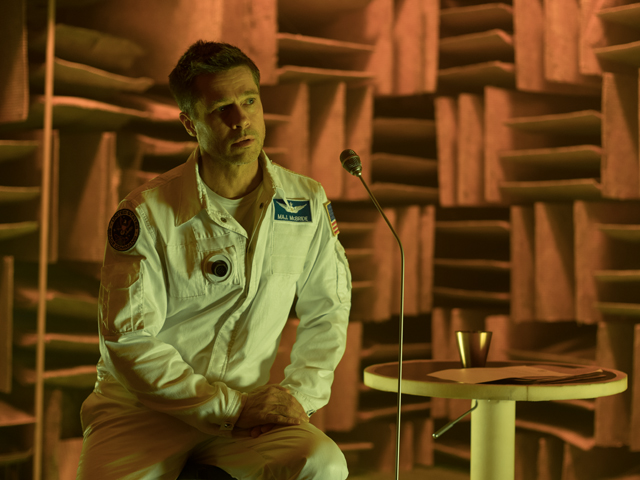
Astronaut Roy McBride
Cast: Donald Sutherland, Brad Pitt, Ruth Negga, Tommy Lee Jones, Liv Tyler
Director: James Gray
Genre: Adventure, Drama
Running Time: 124 minutes
Synopsis: A sci-fi thriller set in the future, AD ASTRA stars Brad Pitt as an elite astronaut who travels to the outer edges of the solar system to find his missing father and unravel a mystery that threatens the survival of our planet. His journey will uncover secrets that challenge the nature of human existence and our place in the cosmos.
Ad Astra
Release Date: September 19th, 2019
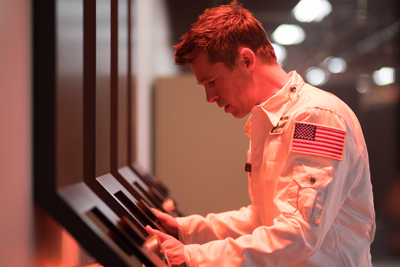 About The Production
About The Production
Roy's Odyssey
Per aspera ad astra: Latin for "Through hardship to the stars."
In the future, astronaut Maj. Roy McBride (Brad Pitt) is leading a team building the world's largest antenna, designed to locate advanced alien life, when a sudden power surge almost costs him his life.
This incident is the latest in a long line of recent catastrophes taking place on Earth, including fires and plane crashes, caused by electrical surges that have been happening due to radioactive bursts. U.S. intelligence believes that these bursts are a result of cosmic rays emanating from explosions that happened near Neptune from The Lima Project, a long-ago mission whose ship disappeared in deep space 16 years after launching.
Director/Co-Producer/Co-Writer James Gray explains, "The idea of the Lima Project was that they would be far from the Sun so its magnetic field would not upset any instrumentation and they would be able to look with great accuracy at the reachable Universe and check for all kinds of planets. The drive was to see if they could find signs of intelligent life."
The commander of the Project was Roy's father, H. Clifford McBride (Tommy Lee Jones), a legendary astronaut who's been missing for 16 years. Even though Roy hasn't seen him since he was 16 years old, Roy has always idolized him, while inheriting his incredible tolerance for risk and his belief that the answers to all of life's physical and metaphysical riddles lie in deep space. But Clifford had been a distant parent and husband and his neglect helped make Roy solitary and remote, closed off from relationships, repressing all emotions positive and negative.
Gray says, "United States government officials come to Roy and tell him that his father, whom he thought was long deceased, is alive and out at the edge of the solar system. Roy has got to communicate with him. They have to find him because he might be doing something horrifying, committing potential acts of terrorism in the rings of Neptune. They want to use Roy to lure him out of silence."
"You can imagine what that must be like for Roy. For 16 years you've thought your father was dead and all of a sudden, he might be alive and out there doing something destructive."
To arrive at The Lima Project, Roy must first travel from Earth to the Moon via commercial shuttle and then transfer to a remote base to meet the Cepheus, the spacecraft that will take him first to Mars. There, he will attempt to contact his father via a secure direct laser link, and, if successful, then on to The Lima.
Accompanying Roy on his journey is Col. Pruitt (Donald Sutherland), a retired SpaceCom astronaut and one of his father's oldest friends. Pruitt tells Roy, who he'd previously met when Roy was just a kid, that his last conversation with Clifford, many years earlier, had not been pleasant; Clifford became angry when Pruitt told him he was leaving SpaceCom.
Their flight to The Moon is uneventful. The Moon has become a series of highly developed outposts colonized by people from various countries from Earth, who, as on Earth, quarrel over resources. However, the areas in between these outposts are as lawless as the Wild West. On their way to the Cepheus, they're attacked by lunar pirates and renegades.
 "Unfortunately," says Gray, "if you look at the history of human endeavor, our species can't seem to get past ideological squabbles. So we have a Moon that's filled with pirates because of the valuable natural resources there along with potential hostages they can hold for ransom. This is a future that has both problems and promise."
"Unfortunately," says Gray, "if you look at the history of human endeavor, our species can't seem to get past ideological squabbles. So we have a Moon that's filled with pirates because of the valuable natural resources there along with potential hostages they can hold for ransom. This is a future that has both problems and promise."
Their military escort is killed and Pruitt is seriously hurt in the attack. Unable to continue on, Pruitt passes on to Roy a highly-classified video from SpaceCom revealing top secret intelligence about The Lima Project. After being away in space for so long without any discoveries, the scientists had become disillusioned. Half the crew wanted to return to Earth, but Clifford, would have none of it. As each faction tried to wrestle control of the ship, some kind of meltdown occurred with the anti-matter that powered The Project, releasing electromagnetic pulses which caused the explosions and threatened the entire stability of the solar system with already drastic effects on The Moon and Mars.
Having lost his mind, Clifford executed the dissenters for mutiny, and since then has been hiding out in space. From the videotape, Roy realises that the real goal of his mission is to quietly coax his father out of the darkness, so that the government can assassinate him and destroy The Lima Project without the public knowing.
Aboard the Cepheus with a crew of four, Roy is annoyed when the Captain, Lawrence Tanner (Donnie Kershawarz), insists on responding to an SOS signal from a nearby Norwegian biomedical and animal research ship, The Vesta. Roy reluctantly agrees to accompany Tanner onboard The Vesta, where they encounter no signs of human life but an enraged research baboon in zero-gravity that attacks and kills Tanner. Roy manages to eradicate the beast and make it back to the Cepheus.
Approaching Mars, Roy has to take over the controls when they experience a loss of power during landing and Tanner's second, Lt. Donald Stanford, (Loren Dean) freezes up. Upon arrival, Roy is met by Helen Lantos (Ruth Negga), the Superintendent of the American Section on Mars, before he's quickly escorted to the secure laser link to contact The Lima Project. Roy's first attempt at reaching his father, reading a statement prepared by officials, is unsuccessful, but after delivering an unscripted informal message, he's informed that he will not be continuing on the mission because he's too close to the subject and poses too much of a psychological risk. They will send the Cepheus crew instead.
Frustrated and angry, Roy turns to Helen, who confesses that, like him, she too was orphaned by The Lima Project, that her parents were among the scientists murdered by Clifford when they wanted to return to Earth. She tells him that the Cepheus is being loaded with nuclear munitions in order to assassinate Clifford and destroy The Lima. Knowing that it's Roy's destiny to complete his journey, Helen leads him to an underground lake where he can gain entry to the Cepheus. Making it aboard just in time, Roy must face off with the crew who have been ordered to terminate him. Following a zero-gravity fight to the death, Roy continues on to Neptune alone--a trip of 79 days, 4 hours and 8 minutes.
Anxious to confront his father, Roy is no longer the emotionally repressed, unsociable man he was when he began his mission. He's had enough of his solitary existence in space. He's ready to try exploring human connections on Earth.
Says Gray, "There's a new passage in his life that's taking hold."
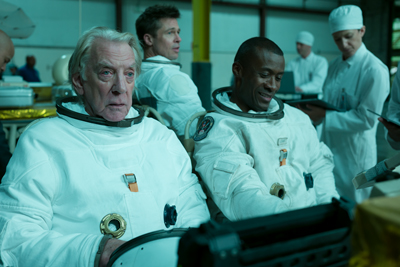 Genesis Of Ad Astra
Genesis Of Ad Astra
Director/Producer/Writer James Gray recalls his initial inspiration for the film came when he was reading about Nobel Prize-winning physicist Enrico Fermi, known as the architect of the Nuclear Age, who believed there was a 90 percent chance that the southwestern part of the United States would be destroyed when they split the atom for the first time.
"They weren't completely sure that the chain reaction wouldn't keep continuing," explains Gray. "I found that extremely alarming and I thought, how would that be if you had nothing to lose and you were in deep space? There's no end to what experiments you might be willing to undergo or to perform.
"Then I started thinking about Joseph Conrad's Heart of Darkness and the movie Apocalypse Now. The idea came from there. It was Heart of Darkness and an attempt to embrace the imagery and the mood of the Apollo and Mercury missions.
Gray's writing partner on Ad Astra was Ethan Gross, his fellow classmate at USC film school and a creative collaborator on many of his films. Explains Gross, "The idea was to have a character on a transformative journey. Like 2001: A Space Odyssey which has the Homeric Odyssey sort of imbued within it. And Apocalypse Now, which obviously adheres to Joseph Campbell's Monomyth, The Hero's Journey.
Gray says, "There have been so many great films made in the science fiction genre, but how many of them are there that move you? I wanted to do something that was the opposite of most space travel movies that offer a somewhat positive view which results in meeting aliens, intelligent life that are benevolent or at least interesting enough to involve us. I tried to do the opposite of that and say, what if there's nothing? What if there's a kind of emptiness out there that we can't even grapple with?
"I was anxious to explore the fact that as human beings, we're not really meant to be in space. We're not designed to be floating around 250 miles outside the atmosphere. We're not built for that, and we're never going to be built for that. And that is going to have a cost."
Recalls Gray, "I'd read this quote of Arthur C. Clarke (who wrote 2001), "Either we're not alone in the universe, or we are, and both are equally terrifying." And I thought, well, I've never seen a movie about us being alone.
So, I thought combining that with this person out there doing experiments, which are very hazardous and that's sort of the way the story began to take shape, and who they would send to try and negotiate with that guy, maybe it's a father/son story, that's very mythic, and that's kind of how it began to come together in my mind."
Gray, who considers Ad Astra more science-future-fact says, "I thought that this idea of space travel is both beautiful and horrifying at the same time. I'm hugely in favor of space exploration and missions to Mars. But sometimes exploration is also a means of escape. I hope people understand that at some point it is incumbent on us to both cherish exploration and to cherish the Earth. The Earth and the human connection are worth preserving at all costs."
 Gross says, "This movie isn't the future, it's a future. This story is not necessarily the future we think is going to happen, it's not a predictive movie. It's just a film about what could happen if space exploration continued and we populated the Moon and Mars and beyond.
Gross says, "This movie isn't the future, it's a future. This story is not necessarily the future we think is going to happen, it's not a predictive movie. It's just a film about what could happen if space exploration continued and we populated the Moon and Mars and beyond.
"This movie is almost an extension of the '60s and '70s space technology, as if it had progressed, jumped into the future without most of the things that I think most of today's science fiction movies are made of."
Gray allows that he tends to view progress in a mostly optimistic way and is resistant to making films that present a dystopian future in which everything is terrible. Neither does he want to make a movie that says in the future everything will be incredible and great.
"I actually think it will be more or less like we live now," he says "but with a few more gadgets.
"We did a lot of research to make it as believable and scientifically accurate as possible. But we always let the story be the main impetus to drive the movie."
They drew from their own experiences in creating their protagonist, Roy.
Says Gray, "I viewed Roy as an extension of practically everybody I know, including myself, who is headed somewhere, but not exactly sure where. Roy is thinking he knows what he wanted and even got a little of it, but there's something seriously lacking. There's a hole that needs to be filled inside and he can't verbalize it yet."
'So, the whole point of the movie is, how to fill that hole. It's really about his solitude, about how alone he is, about how he has all this information he can't communicate to these other people, about how he doesn't know them, and about how that's how everybody wants it. The more connection there is, the more risk there is, the more risk to the mission, the more risk there is to him personally. And so, he meets these other people, but doesn't care about their reality."
Explains Gross, "Roy feels fully alive when he's up on top of the Earth's atmosphere, when he's away, when he's exploring. That's when he feels alive. And he has a relationship with this woman, Eve, who cares about him and he seemed to care about her but he's got something, a block in him, that makes him push her away.
"And it's caused by his father--his father's abandoning him years ago led to his inability to have intimacy in his life, just like his father."
Gray says, "So he's not just alone, but a loner. Someone who, in a way, prefers it. At least it in the first half of the movie, and has to deal with his own issues, and actually, if you can't express things to people, if you have to keep things a secret, that's a huge cause of anxiety, not being able to reveal yourself to anyone or anything."
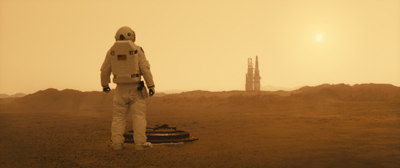 All through his assignment, Roy is monitored, and not only for his vitals. Says Gray, "The idea was to chart his psychological state, and let's be honest, in such a circumstance, there's this potential catastrophe, there's this struggle to get to know who your father was, and of course, all this is against the back drop of having to leave the Earth, having to leave terra firma. So, that's a whole lot for a person to try to absorb, and I think he kind of breaks a little bit. The risk to his psychological state was even greater than his physical state." Gross adds, "Along the way, Roy realizes that he's sort of turning into his father, and he has to stop that. He doesn't want to be his father-- somebody that escapes his humanity. And he finally is determined to return to Earth and become a father and a caring, connected human being, a man who is not afraid of intimacy with other people."
All through his assignment, Roy is monitored, and not only for his vitals. Says Gray, "The idea was to chart his psychological state, and let's be honest, in such a circumstance, there's this potential catastrophe, there's this struggle to get to know who your father was, and of course, all this is against the back drop of having to leave the Earth, having to leave terra firma. So, that's a whole lot for a person to try to absorb, and I think he kind of breaks a little bit. The risk to his psychological state was even greater than his physical state." Gross adds, "Along the way, Roy realizes that he's sort of turning into his father, and he has to stop that. He doesn't want to be his father-- somebody that escapes his humanity. And he finally is determined to return to Earth and become a father and a caring, connected human being, a man who is not afraid of intimacy with other people."
The inspiration for Clifford came from not only Conrad but Melville. Gray says, "I'm a big fan of Moby Dick, and I always felt that McBride was sort of an Ahab figure. That he had become obsessed with his 'white whale' of trying to find all the cute little aliens that were going to bail us out and provide us with answers."
Gross explains, "Roy's father, Clifford, wanted to be the first person to discover meaningful life outside of our planet and years and years have gone by and most of the people in the Lima project had become disillusioned thinking that there's no signs of life.
"But Clifford is a vain man, and he's determined, he's not going to give up. He's going to stay there even after the last member of his team is dead and is going to keep looking for life outside of Earth.
"He clearly doesn't care about anything on Earth. He doesn't care about the lives of his own fellow scientists aboard the Lima project nor anything else."
Roy's meeting Helen Lantos, who's spent her entire life on Mars in an underground dwelling, represents a turning point for him.
Gross explains, "She is sort of a flip side of him. She represents somebody who has also been orphaned by people on the Lima project. She was orphaned on Mars and left there at a young age when her parents enlisted to go on Clifford McBride's expedition. And she had a lot of hurt and anger about that, but unlike Roy, she didn't really bury it. She's been dealing with it and living with it throughout every day of her life and Roy sees that in her."
Gray says, "She's concerned for the other people there. Nobody tells her anything. Roy is the only person that's ever been honest with her. She, in turn, is actually honest with him. I mean, he doesn't have many of those people in his life.
"But there is this bond between them, and although it's not romantic, that's what leads him to acts of desperation, and it's what leads her to help him board The Cepheus to Neptune, even though it will undoubtedly cost her her job and perhaps worse."
To provide insight and information to Roy about Clifford's real nature and intentions, Gray and Gross created the character of Col. Pruitt, an old friend of Clifford's who's assigned to accompany him on his mission. Pruitt knows what has happened to Roy's father and what SpaceCom really intends to do, and represents the kind of human connection Roy has learned to live without.
Says Gray about Pruitt, "He can't go on the journey with Roy. You want him to go, you want him to be a kind of protector for Roy in some way, but he's weak, he can't do it. "
Ad Astra had a long gestation period, not unusual for a James Gray project. Sometime between the director's productions Two Lovers (2008) and The Immigrant (2012), Gray and co-writer Ethan Gross began talking about writing a film set in outer space. They worked on the script off-an-on over the years, then Rodrigo Teixeira's RT Features stepped into develop the script.
In 2016, once Brad Pitt agreed to both star and produce, things moved quickly. His production company Plan B's deal with New Regency provided financing and distribution through Twentieth Century Fox, with Bona Film Group co-financing with distribution rights in mainland China, Taiwan, Hong Kong and Macau.
The film began production in August 2017. 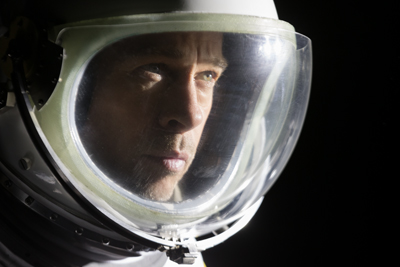 Casting
Casting
Gray was "very pleasantly surprised" when Brad Pitt agreed to play Roy McBride.
Recalls Gray, "Several times over the years Brad Pitt and I had tried to work together on a film but between scheduling and timing, it never happened.
I was absolutely thrilled when he was able to commit to this shooting schedule. Pitt says, "I've always loved James' filmmaking. It comes from a deep knowledge of the history of film. There's always a classic element to his storytelling, very elegant, and really, really points towards the greats. "Our first conversations were about what is connection, especially for a man. And what if we're dealing with a human being where connecting with others is not necessarily in his skillset. He's quite capable, you know, on a tower and in outer space when it gets dangerous. But when it becomes intimate, he's challenged."
Pitt continues, "We see Roy at this point in his life where this is no longer working for him, and he's becoming aware of it. And that is set against finding out that his father may still be alive. And so for James and I, it was really a discussion of vulnerability. What is vulnerability? What is strength in a man? Where does strength really come from? And out conclusion, what we were striving for, is that our strength comes from actually being vulnerable.
"True confidence comes from we as individuals being able to acknowledge our foibles, our shortcomings, our insecurities, and instead of hiding or trying to cover that to actually be very open. And I've certainly found that in life that a great peace and I will say, strength, comes from that very thing, which is antithetical to certainly how my Dad would've grown up.
"These were these early discussions between James Gray and I, and what I found really compelling about what he was after with this piece," Pitt explains.
Gray says, "Brad notices everything. He is so perceptive and a great friend to the director, not just because he's a producer as in this case, but he's an incredibly helpful actor. He's not simply interested in his role; he's concerned with the entire story.
"He's an interesting figure," he continues, "because he is a movie star with movie star looks and charisma, but there's an ambivalence to him about that status. He is an excellent and immensely talented actor; very subtle, wonderful at taking any directions you might give him and then expanding them into something else. There's an effortlessness to what he's doing, like Jimmy Stewart or Spencer Tracy. They almost look like they're not acting. But the acting is incredible, you just don't see the machinery.
"I'm not saying it's effortless for him," laughs Gray, "I'm saying it looks that way to us and that is really very, very rewarding for a director.
"Working with Brad has been spectacular. He's a brilliantly perceptive and absolutely fabulous actor. He is so generous emotionally, with his time, it's been a real treat."
Of Ad Astra, Pitt says, "It's a film I think that has its roots in '70's films, as James' vernacular seems to be born from. Meaning that it's contemplative. It unfolds. And we have big moments of action and spectacle that on the big screen is pretty jaw-dropping."
To portray Roy's revered, enigmatic father, Clifford, the filmmakers cast Academy Award®-winner Tommy Lee Jones.
Says Jones, "I love science fiction, and I thought this story and this screenplay were really cool."
Jones describes his character as "a great astronaut, an explorer, who becomes a dangerous man. A lost man."
Says Gray, "Tommy Lee Jones is about as intense a person as you can get in a movie and a legend. A force, he's explosive. So much danger. You put the camera on him, and he's incredibly frightening.
"And Tommy Lee is about an interior process, about the work, and your direction to him is, by necessity, very simple, very on point, the adjustments are very on point, and then he looks at you for a beat, and goes, 'All right, let's try it.' "And then, he'll do a take, and it'll have your adjustment, it'll be beautiful, and he's extremely prepared and precise, and he will do exactly what you ask, and he will do exactly what he thinks is right, too, in the take. And, like I said, his inner life is very present on screen. You feel a real darkness on screen in a beautiful way. He's fantastic."
 Pitt says, "Tommy Lee Jones was perfect to play Clifford because of his weight, his gravitas. He's known for being highly intelligent, highly capable, and it just fit. It's seering. He's a master. Absolute master. He leaves an indelible mark on a film."
Pitt says, "Tommy Lee Jones was perfect to play Clifford because of his weight, his gravitas. He's known for being highly intelligent, highly capable, and it just fit. It's seering. He's a master. Absolute master. He leaves an indelible mark on a film."
Says Jones, "I liked working with James and Brad. It was a great deal of fun, a terrific adventure. A happy adventure."
For the character of Helen Lantos, the filmmakers cast Academy Award®- nominee Ruth Negga, who had co-starred with Brad Pitt in World War Z. She was delighted to reunite with them and eager to work with Gray, who believed Ruth would bring exactly the right qualities to Helen to really ground the film while serving as a catalyst to encourage a more empathetic, compassionate Roy. Says Negga, "My part is quite condensed and small. James wanted Helen to be very much a root of the human experience, even though she doesn't appear very much in the film."
Gray explains "For Helen, a woman born and raised on Mars, you needed an emotionality - a connectedness. I had seen Ruth in Loving and thought she was terrific, and here she was just extraordinary, just an unbelievable depth, an interesting, wonderful actress."
One of the screen's most respected and admired veteran actors, Donald Sutherland, portrays Col. Pruitt. Like Negga's, his is a relatively brief, but crucial role, and Sutherland was enthusiastic to join Pitt and Gray for "something that is truly worth seeing and worth thinking about after you've seen it. If you can make a film that makes you think, that's grand," Sutherland.
Says Gray, "Donald is a brilliant actor. Like Tommy Lee, he's very prepared, but Donald's different because rather than it being primarily an interior process, Donald likes to work with a lot of outside stimuli. "He wants your input, he wants a lot of dialogue, he wants a kind of very open atmosphere on set."
Pitt says, "It was a real pleasure for me to be able to work with the great Donald Sutherland. He's been a part of so many of my favorite films. And so to be able to have this experience, this exchange, was pretty monumental for me. He's incredibly giving."
About working with Gray, Sutherland says, "James was lovely. He kind of lets you just do it hoping that you will find your way and then he will give you a little twitch, a nudge, until he gets what he wants. He's so smart, and it's such a delight to work with him, to have the opportunity to please his desire, his vision, his ambition. I've not worked with anyone quite like him before. It was extraordinary."
Liv Tyler (The Lord of the Rings, Armageddon) appears as Roy's former partner, Eve, shown primarily in flashbacks.
Rounding out the cast, the filmmakers chose Donnie Keshawarz ("Forever," "Damages"), Loren Dean (The Mule, "Gray's Anatomy"), Kimberly Elise (Death Wish, Hellbent), ("The Good Fight" "The Blacklist: Redemption") and Bobby Nish ("Sons of Anarchy," "Southland") for the roles of The Cepheus' crew members Captain Lawrence Tanner, Lt. Donald Stanford, navigational specialist and geologist Lorraine Deavers and medic Franklin Yoshida, respectively.
The Experts
One doesn't make an authentic science-fact-fiction film without some real data from the experts. For that, the filmmakers turned to NASA, along with other space agencies.
Retired astronaut Garrett Reisman, who flew two Space shuttle missions to the International Space Station (2008, 2010), was one of Gray's early fountains of space travel information. Although he was present during production only for those scenes and areas where his knowledge and expertise were specifically required, he also spent time with Gray during the script writing process.
"A lot of us now are looking at maybe making a sustainable human presence on another planet in our solar system, and specifically the red planet, and thinking about all the wonderful utopia that it might be," he states. "And I think that we have to consider, what if it turns out that it's not a utopia. What if it's a dystopia?
"And what if we can break the bonds of gravity and with our rockets and that advanced technology transport humanity to another planet, but we take our human failings along with us? What if it doesn't turn out well? James explores that with this movie."
Another resource was Aerospace Engineer Robert Yowell, a 30-year veteran of the Space program, beginning in 1989 as an engineer with NASA.
"James wanted as much realism as possible on this film," says Yowell. "I read the script and pointed out some suggestions. What he was looking for in terms of realism was the physics. For instance, could you fire a gun on the Moon? The answer is yes, a standard gun will work in space; a bullet has its own oxidizer. Another question was, can you talk to somebody on Neptune from Earth in real-time? Unfortunately, you can't. As far as we know, the speed of light is the speed of light, so you've got a considerable delay in terms of hours. "What would blood look like in zero gravity? What would a dead person look like in space? These are things that are macabre to think about, but someday someone is going to have to deal with those eventualities. And yes, the way those things will look is physics.
"He also had questions about nuclear and gamma ray radiation, neutron radiation, matter and anti-matter. Our conversations were always very interesting and his questions well thought out."
Says Gray, "The entire group at Lockheed Martin as well has been very helpful. I've asked them every question known to man."
When the director was deep in the middle of pre-production, he hosted an "astronaut dinner."
"We invited astronauts and several experts from NASA, JPL and SpaceX, among other firms. It was a spectacular exchange of ideas and insight into where they think things are going and where they have been. Sometimes you have to look backwards in order to look forward. It was very instructional to me."
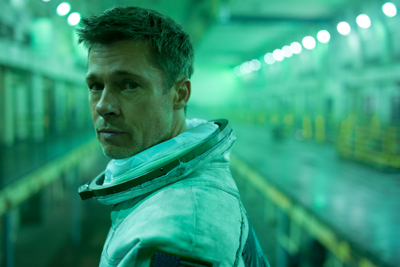 About The Production
About The Production
According to Gray, "The job of the director is to set the context through which other people can create and do wonderful things. Our production designer Kevin Thompson's design is always rooted in something tangible that we could understand. We looked a lot at Skylab and the ISS in terms of space stations, the interior of a space shuttle and then tried to update them. Again, the idea of science-future-fact.
"Kevin did a brilliant job, but his brilliance also was a challenge for me because we shot in such very cramped quarters, which was the goal because that's what it is really like. And we had to build the sets twice, because we had to have both horizontal and vertical versions. There were times when Brad would be in a harness hanging thirty feet up and the camera would be looking up at him as he was hanging. It looked like zero gravity, but it was very arduous." The appeal for Thompson was that "the script was very existential and not your typical sci-fi outer space movie," recalls the designer.
"James liked the details of the International Space Station and people living in tight claustrophobic spaces. The human aspect was very important to him. He was against a cruise ship fantasy vision of the future.
"He was curious about early American projects that were part of NASA history. He really had the spaceships down; he understood the feeling of man being alone when outside of the spaceship and how miniscule he is in relation to the galaxy."
One of the strongest references Gray gave Thompson was the documentary For All Mankind with its extremely high contrast. "James is very visual," says Thompson.
For a film that takes place mostly in outer space, Ad Astra has very little green screen and CGI work.
"It was a deliberate attempt to do as much practically as possible," explains Thompson. "All the monitors, the cockpits, and the backings are practical, which fit James' aesthetic and feel for the movie. We did have to use some green screen when we filmed the exterior scenes in space."
Relates Gray, "We tried to approach this with an eye towards as much authenticity as we could. We saw the Moon as more or less a very highly developed series of outposts. Then on Mars, which is sort of the last manned outpost for our film, we looked at images of a scientific outpost in Antarctica today."
"When you do a period movie," explains Thompson, "not everything should be from that moment in time. Early on we had an expression: look to the past to see the future. We included things from different time periods to represent the idea of new technology colliding with things from the past. We wanted it to feel fairly classic and timeless."
What you won't see in Ad Astra are futuristic gadgets and weapons. "We're taking a little step backwards," says Thompson, "with people still using paper, still using old systems of communication.
"We didn't want to distract with futuristic technology. The most futuristic item we have is a little, clear scanner because the screens will be transparent and project information on them. We use those, but we also used tablets and flat screens for video imagery. It feels minimal enough that it won't appear too dated. I think those screens and tablets are going to be around for a long time."
Finding Earth, Moon, Mars And Neptune In The City Of Angels
For most of the sets representing the Earth, the Moon, Mars and Neptune, the filmmakers chose to shoot on practical locations rather than on stages. This entailed a search that covered miles and miles of Los Angeles County. Thompson, Von Hoytema and the location team searched high and low looking for environments that would match Gray's vision.
Location manager Chris Kusiak admits that finding locations for AD ASTRA was challenging and that he actually scouted places that he had never been to before.
"We needed a lot of underground sites, and Los Angeles is not a city for that – that's more New York or Pennsylvania.
Locations included an abandoned department store in downtown Los Angeles, which housed the former Red Line train station that used to terminal underneath the building. A giant tunnel there was the main attraction to the filmmakers as it would represent below ground on Mars and be the path Roy would take to sneak into the Cepheus on the next step of his journey toward The Lima. Additional downtown Los Angeles locations included the Hall of Records and the city's iconic Union Station.
A former Los Angeles Times printing facility in Orange County stood in for the launchpad for the trip to the Moon. For the pirate attack on the Moon sequence, they travelled to Dumont Dunes in the Mojave Desert.
"Earth, which is only a quick moment in the film, was the only area where we have natural daylight, windows, a glimpse of the outdoors," says Thompson.
"Aside from the race across the Moon's surface to SpaceCom, the only place where they're above ground on the Moon is the hotel room with a window looking out over the complex. Then we start going underground. "The Moon, the main lunar concourse and tunnels were all polished concrete and rough-faced concrete. It had a fairly neutral clean palette with tones of gray and brown, because we wanted to reserve color for Mars."
"It was a real evolution defining what Mars was. We went to a number of older, odd-shaped buildings. We didn't know what it was but we knew that it was also going to be underground. We didn't want it to be cliché, or like anything anyone had seen before. We ended up in an unoccupied power plant. We wanted the lighting to make it feel and look like being in a humid incubator."
Lighting The Future
Academy Award®-nominated cinematographer Hoyte van Hoytema (Interstellar) joined the production for his second foray into space. "Hoyte goes in and is the floor commander," says Gray. "And I was very grateful for that on this movie because there was a lot of technical things that he had done already on Interstellar that I just didn't know at all – things to do with filming zero gravity, shooting on horizontal and vertical sets and doing it effectively and efficiently.
"He has a crew that always works with him and are dedicated to him and to the movie. They're amazing."
Production designer Kevin Thompson acknowledges he felt that the decision to shoot on film rather in a digital format was an enormous help in capturing the various planets' atmospheres.
"With film you capture so much more of the image, and you get details that you don't with digital. The Mars communication center, the rotunda and Shunga Parlor took on an atmospheric color that was sort of an orangey-gray light with some fog to enhance the sense that it was humid and damp."
Dressing The Future
"When you think about costumes for a science fiction movie," relates Gray, "it's one of the great challenges because the clothing gets dated instantly, no matter how artistic you get with a zipper or pocket. I wanted to have someone who was not typically regarded as a science fiction designer, someone totally out of the box.
"When I contacted Albert, I brought a book I have called Moon Fire, which has all these images of Buzz Aldrin, Neil Armstrong and Michael Collins at home, basically showing how engineers dress, with simple turtlenecks and plaid short-sleeved shirts."
Costume designer Albert Wolsky, winner of two Academy Awards® (All That Jazz, Bugsy) and five additional Oscar® nominations, says, "James wanted the look to be banal, almost ordinary. I knew exactly what he meant. The job was finding a way to make it banal and ordinary yet 100 years in the future, which was difficult because I knew the results had to be totally invisible. He was very clear that it was important to him that the wardrobe not be 'costumey.'"
One of Gray's requests to Wolsky was that the space suits be very close to what the Apollo team wore, which is why they are completely different from those in current space movies where they have been totally invented. "We went as close as possible to the original ones, which weigh 30 pounds. We cut that down to 15 pounds, and they are still authentic looking. Space suits come complete with a cooling system, materials that expand and contract from pressure, and of course a computer. There's an entire world inside that space suit. We actually had the same cooling systems that are used in space installed in ours to keep the actors from dying from the heat."
Gray says, "What I most love about the work is that you don't notice the costumes at all. People are wearing what they should be wearing, which is hard in a science fiction movie."
Summing up the experience of making Ad Astra, Gray says, "It's been a fantastic journey."
Ad Astra
Release Date: September 19th, 2019
MORE



